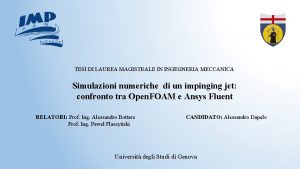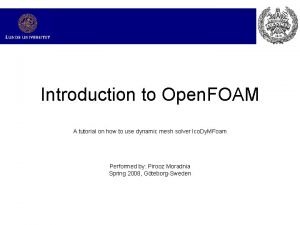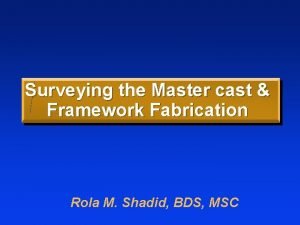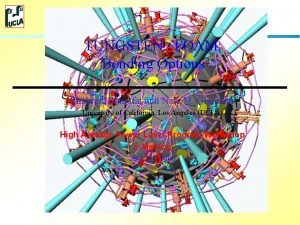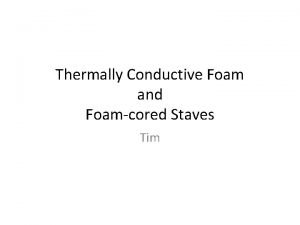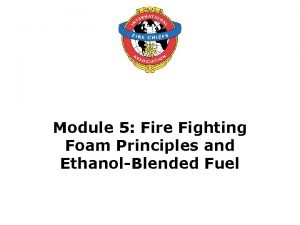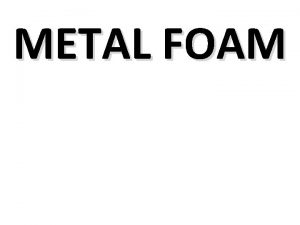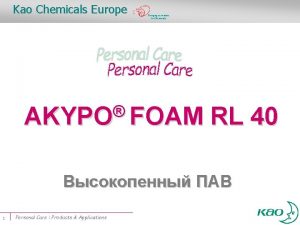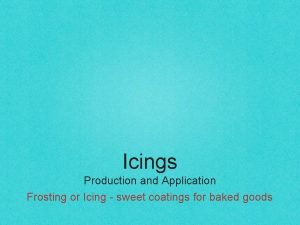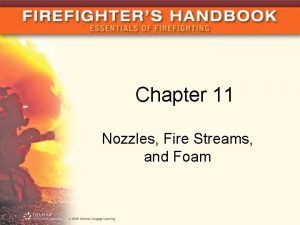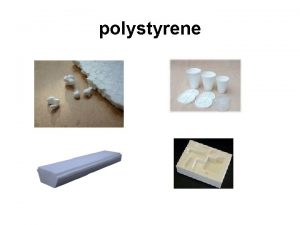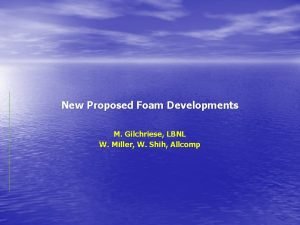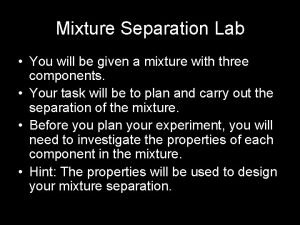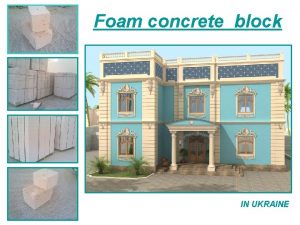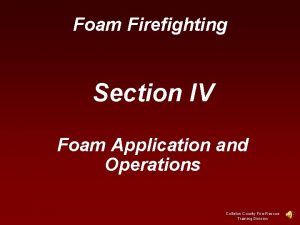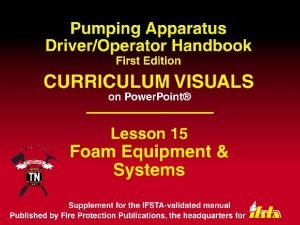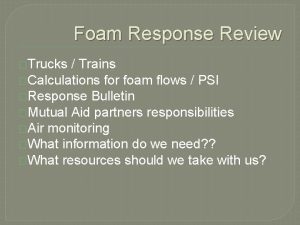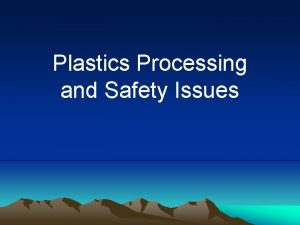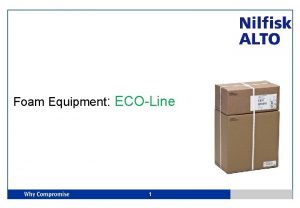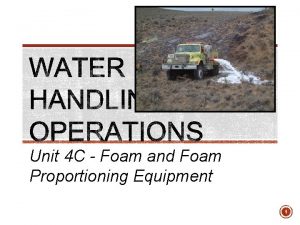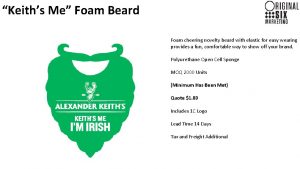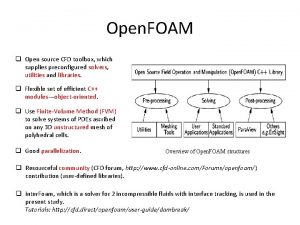Cast NetModeling for Open FOAM Cast Net Modeling





















- Slides: 21

Cast. Net-Modeling for Open. FOAM® Cast. Net: • Modeling and meshing environment for CFD and FEA • CAD-Model based (reads Parasolid -xt, Acis –sat or Granite Pro-E parts) • Generates hybrid meshes • CFD specific features (boundary-layer-meshing) • Direct Open. FOAM-Modeling (boundary-layer definition, zones, solver, material…) • Cast. Net is based on Simmetrix Inc. meshing, CAD preparation and abstract modeling technology OPENFOAM® is a registered trade mark of Open. CFD Limited This offering is not approved or endorsed by Open. CFD Limited, the producer of the Open. FOAM software and owner of the OPENFOAM® and Open. CFD® trade marks.

Example 1: Cast. Net Modeling for Simple. FOAM Mesh generated in Cast. Net Meshing example: Extrusion tool Kindly provided by Institut für Kunststofftechnik, Universität Stuttgart

Example 1: Simple. Foam-Modeling Parasolid model import

Example 1: Simple. Foam-Modeling Some solver setup, control. Dict and material panels

Example 1: Simple. Foam-Modeling Some boundary and Initial conditions panels Option: Initializing with potential. FOAM and apply. Boundary. Layer

Example 1: Simple. Foam-Mesh Extrude regions Transition of boundary layer from free-mesh to extrude region Extrude region Small gaps with boundary layer Curvature controlled meshing

Example 1: Simple. Foam-Mesh All faces meshed with prism layers: Able to handle difficult situations CAD-Model Sliver face suppression Mesh

Example 1: Simple. Foam-Output Automatic script export: Case is setup with one command Only original Open. FOAM commands and inputs are used

Example 1: Simple. Foam+ Heat. Transfer Results Rheological investigations of molding process at IKT, Stuttgart

Example 2: Cast. Net Modeling for rho. Porous. Simple. FOAM Mesh generated in Cast. Net

Example 2: rho. Porous. Simple-Foam-Modeling Addressing of porous regions in CAD-Model (highlighted in white)

Example 2: rho. Porous. Simple-Foam-Modeling Addressing of baffle-faces in CAD-Model (highlighted in white)

Example 2: rho. Porous. Simple-Foam-Mesh Extrude with various section diameters Transition of prismlayer from extrude to free-mesh Extrude with mesh distribution

Example 2: rho. Porous. Simple-Foam- Mesh Boundary-Layer Transition from baffle Face

Example 2: rho. Porous. Simple-Foam- Results

Example 3: Cast. Net Modeling for Inter. FOAM Meshing with Snappy-Hex-Mesh Reason for additional snappy. Hex. Mesh-Modeling: In general: • Providing a single modeling environment that covers the various demands of different Open. FOAM solvers or numerical methods In particular: • Hex-dominant meshes work better with certain solver (e. g. *Inter. FOAM) • Grid studies can be easily carried out (switch from Cast. Net-Meshing to snappy. Hex. Meshing without changing solvers, models or boundary definitions) • Surface grid can be still generated in Cast. Net based on poor and defect CAD models (base for snappy. Hex. Mesh volume mesh)

Example 3: Inter. FOAM with Snappy. Hex. Mesh-Modeling Solver-setup and boundary definition just like in Cast. Net-Meshing Refine faces and layer faces can be picked in the CADmodel Snappy. Hex-Mesh Calculator estimates block. Mesh. Parameter and subdivisions

Example 3: Inter. FOAM with Snappy. Hex. Mesh-Modeling All Snappy. Hex. Mesh. Dict. Parameters can be set Option to define more parameters Local init with set. Fields

Example 3: Inter. FOAM with Snappy. Hex. Mesh-Modeling Exports: Snappy. Hex. Mesh. Dict Block. Mesh. Dict Special stl-File + scripts to manage the mesh and job Example: Face-Handling Exported snappy. Hex. Mesh. Dict: All faces are available: Faces are automatically collected to boundary-Patches using create. Patch after the meshing

Example 3: Inter. FOAM with Snappy. Hex. Mesh

Example 3: Inter. FOAM with Snappy. Hex. Mesh: Results Animation will be shown in display mode
 Open foam corso
Open foam corso Open foam
Open foam Helen erickson biography
Helen erickson biography Dimensional modeling vs relational modeling
Dimensional modeling vs relational modeling Open innovation open science open to the world
Open innovation open science open to the world Parallel block out
Parallel block out Tungsten foam
Tungsten foam Thermal conductive foam
Thermal conductive foam Non aspirating nozzle
Non aspirating nozzle Metal foam advantages
Metal foam advantages Akypo foam rl 40
Akypo foam rl 40 Flat type icing
Flat type icing Foam pro 1600
Foam pro 1600 Boat flotation foam requirements
Boat flotation foam requirements Foam plastic insulation
Foam plastic insulation Lightweight foamed concrete fill
Lightweight foamed concrete fill Solid-stream nozzle in fire fighting
Solid-stream nozzle in fire fighting Bat tree snot ink looted
Bat tree snot ink looted Eps foam pro
Eps foam pro Foam cells definition
Foam cells definition Compressed rvc foam
Compressed rvc foam How do you separate sand and finely ground polystyrene foam
How do you separate sand and finely ground polystyrene foam
